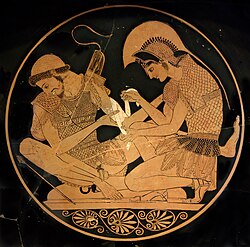Trojan horse
The Trojan Horse is a tale from the Trojan War about the subterfuge that the Greeks used to enter the city of Troy and win the war. In the canonical version, after a fruitless 10-year siege, the Greeks constructed a huge wooden horse, and hid a select force of men inside. The Greeks pretended to sail away, and the Trojans pulled the horse into their city as a victory trophy. That night the Greek force crept out of the horse and opened the gates for the rest of the Greek army, which had sailed back under cover of night. The Greeks entered and destroyed the city of Troy, ending the war.
Metaphorically a "Trojan Horse" has come to mean any trick or stratagem that causes a target to invite a foe into a securely protected bastion or place. A malicious computer program which tricks users into willingly running it is also called a "Trojan horse".
The main ancient source for the story is the Aeneid of Virgil, a Latin epic poem from the time of Augustus. The event is also referred to in Homer's Odyssey. In the Greek tradition, the horse is called the "Wooden Horse" (Δούρειος Ἵππος, Doúreios Híppos, in the Homeric Ionic dialect).
According to Quintus Smyrnaeus, Odysseus thought of building a great wooden horse (the horse being the emblem of Troy), hiding an elite force inside, and fooling the Trojans into wheeling the horse into the city as a trophy. Under the leadership of Epeius, the Greeks built the wooden horse in three days. Odysseus's plan called for one man to remain outside the horse; he would act as though the Greeks had abandoned him, leaving the horse as a gift for the Trojans. An inscription was engraved on the horse reading: "For their return home, the Greeks dedicate this offering to Athena". Then they burned their tents and left to Tenedos by night. Greek soldier Sinon was "abandoned", and was to signal to the Greeks by lighting a beacon. In Virgil's poem, Sinon, the only volunteer for the role, successfully convinces the Trojans that he has been left behind and that the Greeks are gone. Sinon tells the Trojans that the Horse is an offering to the goddess Athena, meant to atone for the previous desecration of her temple at Troy by the Greeks, and ensure a safe journey home for the Greek fleet. Sinon tells the Trojans that the Horse was built to be too large for them to take it into their city and gain the favor of Athena for themselves.
...
Wikipedia

